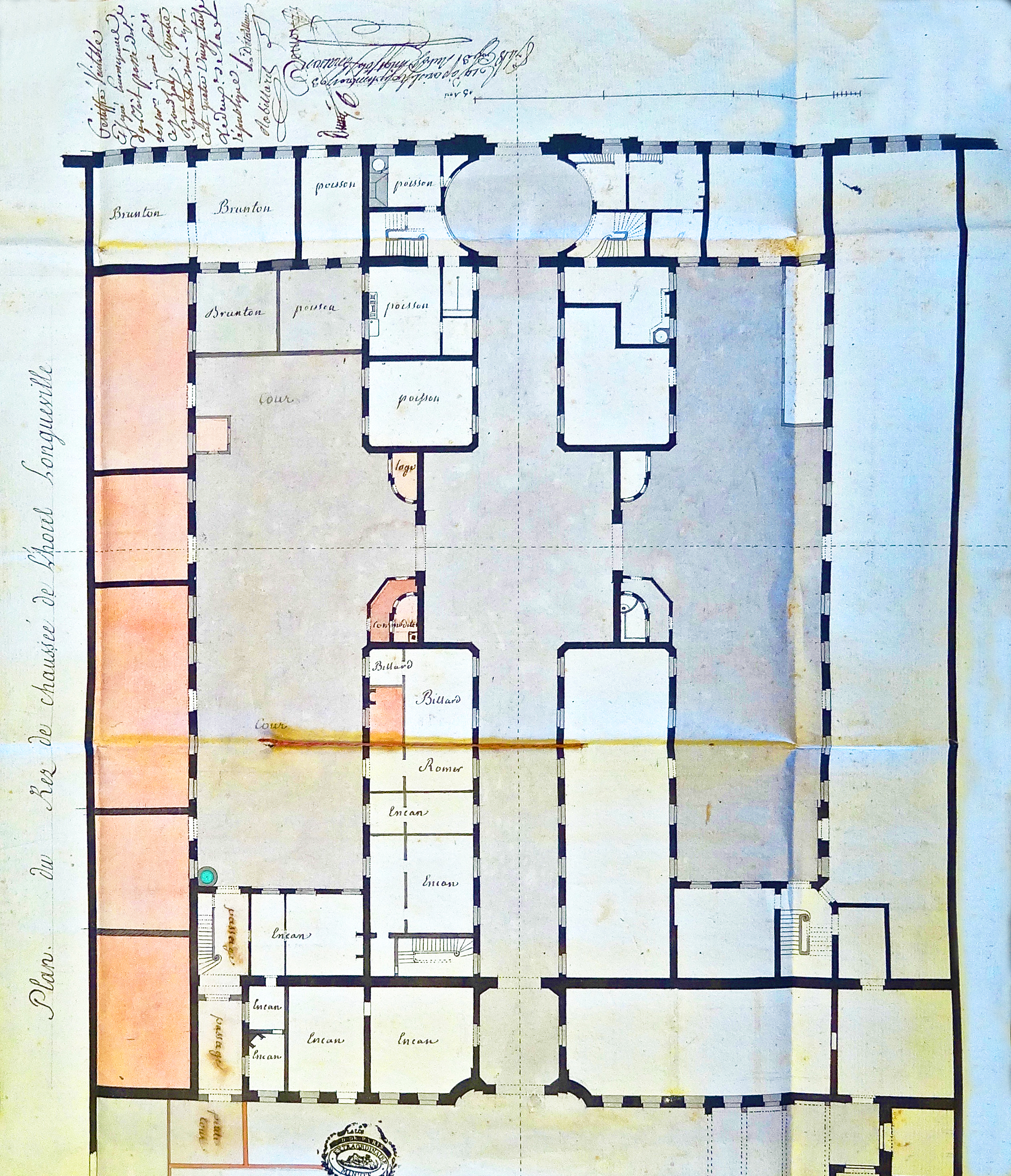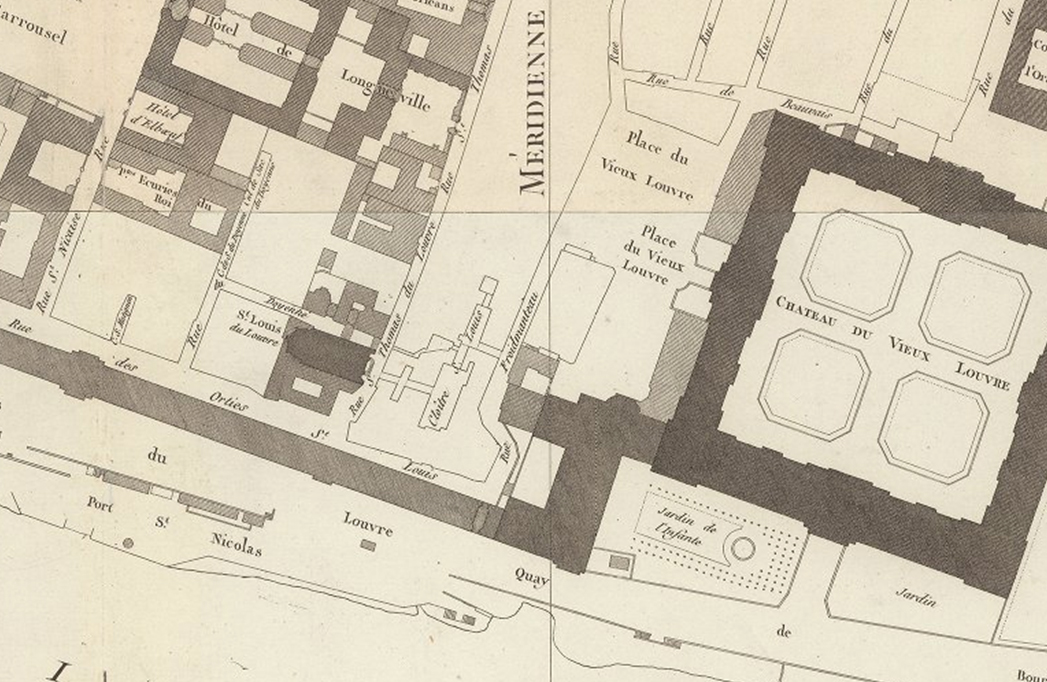Hôtel de Longueville 1793 West
Géricault Life
1793 Plan du Rez de Chaussé of the Hôtel de Longueville produced for the revised lease agreement of September 5, 1793, between Jacques Florent Robillard (representing the Robillard tobacco concern) and Jean Marie Détailleur, who held the government lease, “Citoyen Détailleur au Citoyen Robillard Bail à Loyer,” MC/ET/XCVI/565 Notaire Doillot – Image courtesy of the Archives Nationales (France).
The plan above orients south, rather than north. I have left this original orientation intact for legibility. Thus, the space in red is the southern part of the Hôtel de Longueville – closest to the Seine river and the Galeries du Louvre. The street on the extreme right side of the plan (west) is the rue Saint Nicaise. The text description in the upper right of the plan opens onto the Place du Carrousel, where the guillotine was situated in the late summer and fall of 1792. The Tuileries palace (destroyed by the Commune in 1870) would be further to the right, perpendicular to the east-west of the structure above orientation above. Today, the Louvre pyramid, and space west of the pyramid, occupies the site where the Hôtel de Longueville above long stood.
Hôtel de Longueville (south-west quadrant) 1793
In 1791, the Hôtel de Longueville was the Paris home of Jean Baptiste Caruel, Théodore Géricault’s closest uncle, and the centre of activity for the Géricault family in Paris. Jean Baptiste Caruel was a founding partner of the Robillard tobacco concernt based at the Hôtel de Longueville, which employed Théodore’s father from 1797 until 1810. Several other important Géricault relations also lived and worked at the Hôtel de Longueville. Our focus in this article will be on the south-west quadrant of this historic edifice, long since demolished.
The Hôtel de Longueville was also known as the ci-devant Hôtel de Longueville, and the more neutral Maison Longueville. The property had been the headquarters of the royal tobacco monopoly for four decades, and a tobacco manufactury and distribution center. When Jean Marie Détailleur obtained the nine-year lease for the Hôtel de Longueville, in September 1791, a condition of the lease required the lease-holder to sell the existing stock of tobacco and to maintain an un-interrupted flow of tobacco products to the French public. The Robillard-Caruel tobacco concern bid for the rights to take over these responsibilities as sous-locataires, or sub-lease holders that same month. The 1793 plan here was produced when the original Robillard sub-lease of September 1791 was revised.
The passage we see running east-west through the center of the stucture (left to right) was know as the Passage Longueville. One of the conditions of the Robillard-Détaileur lease was to ensure public use of the Passage Longueville, as it was known. The Passage Longueville running through the Hôtel de Longueville from the rue St. Thomas du Louvre, out of view to the east, to the rue St. Nicaise and the Place du Carrousel in the west above, was a throughfare and the site of a variety of shops, residences, and businesses.
The buildings without tenant names were leased by Étienne Anisson-Duperon – the largest sub-lease holder at the Hôtel de Longueville, who did not survive the period of Terror of 1793-1794. Anisson-Duperon in turn leased part of the space he controlled within the Hôtel de Longueville to various businesses, as did the Robillard tobacco concern. Jean Baptiste Caruel, Théodore’s uncle, managed these sub-leases for the Robillard tobacco firm. The most significant Anisson-Duperon sublease holder was Louis Rondonneau, who remained active at the Hotel de Longueville after Anisson-Duperon’s execution in 1794. Rondonneau operated one of the most important publishing houses in Paris specializing in legal texts. Rondonneau is a significant figure in his own right. We discuss these individuals elsewhere.
In our July 2019 issue we reminded readers that the Hôtel de Longueville’s proximity to the Tuileries palace and the center of government placed members of the Géricault family close to the violence that erupted in 1795 and after (article name: Thermidor). Théodore had two cousins living at the Hôtel de Longueville at this time. Pierre Robillard was several years older and perhaps a friend of Horace Vernet and other boys living at the Galleries du Louvre in the Tuileries section of Paris.
Amédée Selim Robillard was a year younger than Théodore almost to the day. It is easy to imagine Théodore and Amédée Selim celebrating birthdays together. We will discuss family life and recreation at the Hôtel de Longueville and the family homes on the rue de l’Université and the rue de Belle Chasse elsewhere. The Robillard tobacco firm thrived after Thermidor, in part perhaps due to the support of key family member Paul de Barras, member of the Directory, the five-person executive which ruled France from late 1795.
The Robillard-de Barras family circle expanded when Géricault’s Saint Domingue relations began arriving in Paris in 1797, one of these being Marie Anne Charles de Barras, sister of André Edmond de Barras la Villette, the fallen naval hero who gave his life to advance France’s colonial interests on the west African coast in 1779. (See our January, 2022, issue.)

Image courtesy of the Archives Nationales (France), 1793 Sept. 5 Citoyen Détailleur au Citoyen Robillard Bail à Loyer, MC/ET/XCVI/565 Notaire Doillot
Some Leaseholders at the Hôtel de Longueville
This orientation simplifies the task of reading the names of the sub-lease holders in this quadrant of the Hôtel de Longueville. The space in red indicates the tobacco manufactory leased to the Robillard tobacco concern, adjacent to the former Hôtel d’Elbœuf. Brunton’s haberdashery looks out (west) across the Place du Carrousel. Poisson’s restaurant occupies the corner space bordering on the Place du Carrousel and the Passage Longueville. Further east along the Passage Longueville we find Billard, Romer, and then the Encan National, or national auction house on the corner – opening onto the Passage Longueville and a space known as the “second” courtyard. This second couryard was home to several sheds and possibly stables.
Each of these spaces has its own story. We have already discussed Anisson-Duperon’s Republican wallpaper manufactory, Brunton’s silk shop, and the Encan National. (Culture Commerce 3; Birth of a Street; etc.) There were also several other sous-locataires whose names do not appear on this plan. We shall endeavor to present more information about each of these sub-lease holders in future issues.
Our main focus, however, will remain on the Hôtel de Longueville and the impact this space had upon Théodore Géricault and his family. Louis XVI and Marie-Antoinette resided opposite the Hôtel de Longueville. Napoléon watched the attack on the royal residence on August 10, 1792.
The guillotine was erected just outside the western entrance (indicated above) of the Hôtel de Longueville days after the attack of August 10. Brunton’s unlucky staff and customers had a ring-side view, as it were, as did those dining at Poisson’s, until the device was repositioned on the other side of the Tuileries Palace in the spring of 1793. These are just some of the events which occurred within or adjacent to the Hôtel de Longueville.
We have already presented a great deal of new information about Hôtel de Longueville. In the next month or so we will discuss different parts of this imporant site with plans and other archival documents.

1792 Verniquet Map Tuileries (detail ) courtesy of David Rumsey Maps.